Are you confused you Teeth numbers? Do you know we have tooth numbering for each tooth?
Me – “if I put my dead tooth back below my pillow, God will place it back? Then why I am not receiving it back.”
Mom- ” Don’t worry, you will receive more than what you have. Have some faith. A fairy tooth will present you extra teeth.”
We have been growing up listening to the fairy tooth tale.
All the teeth look different.
Every tooth is embedded in the bone called socket, with the part inside called root. The visible portion of the tooth is known as a crown.
Teeth are arranged in a specific way in the mouth.
How many teeth do humans have?
There are four classes of teeth in the mouth.
We bite differently for different kinds of food.
For eating a burger, we use front eight teeth with sharp edges like scissors, thus know as Incisors. They help in biting and cutting the food. There are four incisors in each jaw. The total number of incisors in both jaws is eight.
While eating in KFC, we use sharp pointed teeth lying next to incisors are known as canine. There are two canines in each jaw. So total we have four canines. It helps in tearing the food, especially meat.
We put oats or any soft food item directly on one side of the mouth and start mashing and grinding it. This mode of crushing, mashing, biting is facilitated with premolars and molars. Premolars are a bit smaller than molars.there are four premolars in each jaw. There is a total of eight premolars in adults. They are absent in children. They are known, so because they precede the molars.
Molars are the teeth at the farthest end. Molars have the maximum surface area, and broad .big cusp in the molars not only helps in the grinding of food but also in crushing.there are six molars in each jaw. in total, there are 12 molars in both the jaws.
The first set of teeth a baby has is known as milk teeth or deciduous teeth. Now by early teenage 11-12, these deciduous teeth fell off and replaced by permanent teeth. As the person becomes aged, these permanent teeth also fall off, but any other teeth do not replace them.
Milk teeth are known as deciduous dentition, while teeth for adults are permanent, so they are called permanent dentition.
Upper teeth are placed in an arch form so as the lower teeth.
Both the upper and lower teeth are divided into four sections.
Dental formula
The dental formula is the formula designed for easy remembrance of the number and type of teeth present in children and adults.
The dental formula includes only one side of each jaw and is similar on the other side.
Each jaw is divided into two parts from the midline. It represents only one side of either maxilla or mandible.
Teeth number and names
Incisors- 4 in number. They have a flat surface and sharp horizontal edge to bite and cut food into pieces.
There are two canines. One on either side of the incisors for tearing food. Most active teeth with the longest roots.
Premolars. 4 premolars behind the canine and help in chewing.
There are six molars. They are used in grinding the food before swallowing.
There is a denomination of each tooth, which is represented by the initial letter of its name.
For example, incisors by I, canines by C, premolars by P, molars by M.
If we consider one half of the jaw then dental formula we get
Two incisors
One canine
Two premolars
Three molars
the Dental formula becomes 2123
There are four such jaws. The total number of teeth becomes 32.
Children below 12 years of age don’t have any premolars 2102, so the total number of teeth present in a child is 20
A horizontal line is a line to symbolize the mouth. Up the line, the numerator is the upper or maxillary teeth are addressed and under the line, denominator, we formulate lower or mandibular teeth.
At the age of 19-22, the last molar forms and is accompanied by severe pain at the back of the jaw. An interesting fact is that it is known as wisdom teeth. Not because they are wiser, but they are last to develop.
These are years a person reaches supreme wisdom.
Human being grows two sets of teeth in a lifetime.
Tooth numbering system
Most of the dentists get confused with the tooth numbering system.
There is a dental formula for teeth.
I was getting dental treatment done, and for some reason, I had to travel. Now to get the treatment completed, a dentist should know the teeth he has to work on.
It is essential to see the tooth numbers to maintain a proper record.
We have three most universally trusted tooth numbering systems
- universal system
- palmer system
- FDI system
The horizontal line divides maxilla to the mandible.
A vertical line divides into right and left from the midline
. Your right is the patients left and vice versa.
To remove the trouble, make a plus sign, in the second quadrant, a ‘L’ is formed. So the second quadrant is the patients left. In any of the tooth numbering systems maxillary right side is the first to start.
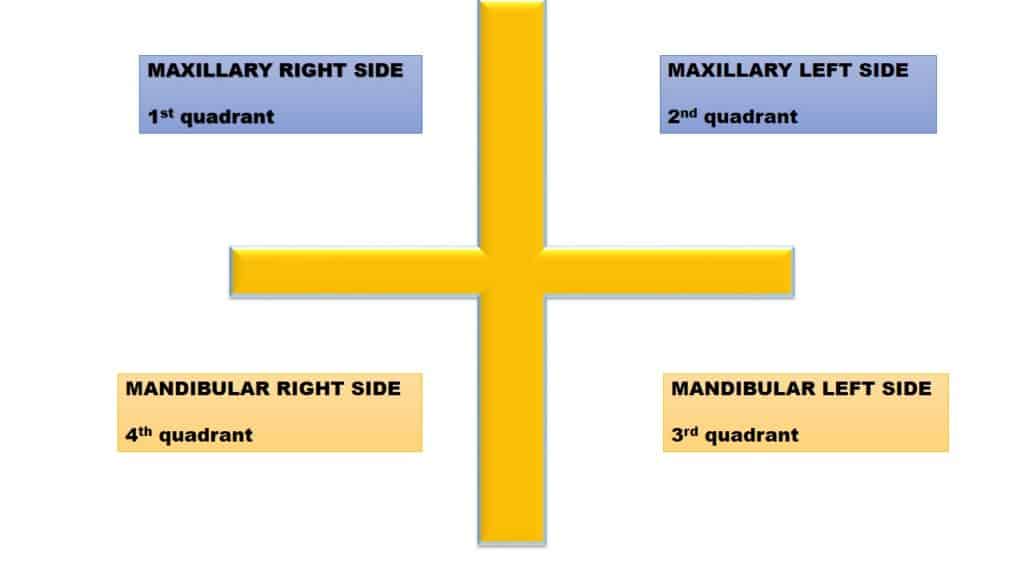
Universal notary system
Universal tooth numbering system for deciduous teeth
Alphabets (A-Z) are used in uppercase. Both horizontal and vertical lines are drawn, starting from

max right quadrant from the last tooth that is
2nd deciduous molar as A
1st deciduous molar as B
canine as C
lateral incisor by D
central incisor by E
continue the alphabets to left maxillary quadrant from central to molar
Teeth numbers for left maxillary quadrant
central incisor as F
lateral as G
canine as H
1st molar as I
2nd molar as J
Instead of starting from the right quadrant. we begin mandibular from left quadrant from molars to central
mandibular left quadrant
2nd deciduous molar as K
1st deciduous molar as L
canine as M
lateral incisor by N
central incisor by O
for mandibular right quadrant continuing from central to molars
central incisor as P
lateral as Q
canine as R
1st molar as S
2nd molar as T
So in the universal system for deciduous, we mark from Ato T. starting from the maxillary right quadrant proceeding to the left maxillary quadrant, then coming to mandibular left quadrant and finally to mandibular right.
Universal Tooth Numbering System in permanent teeth
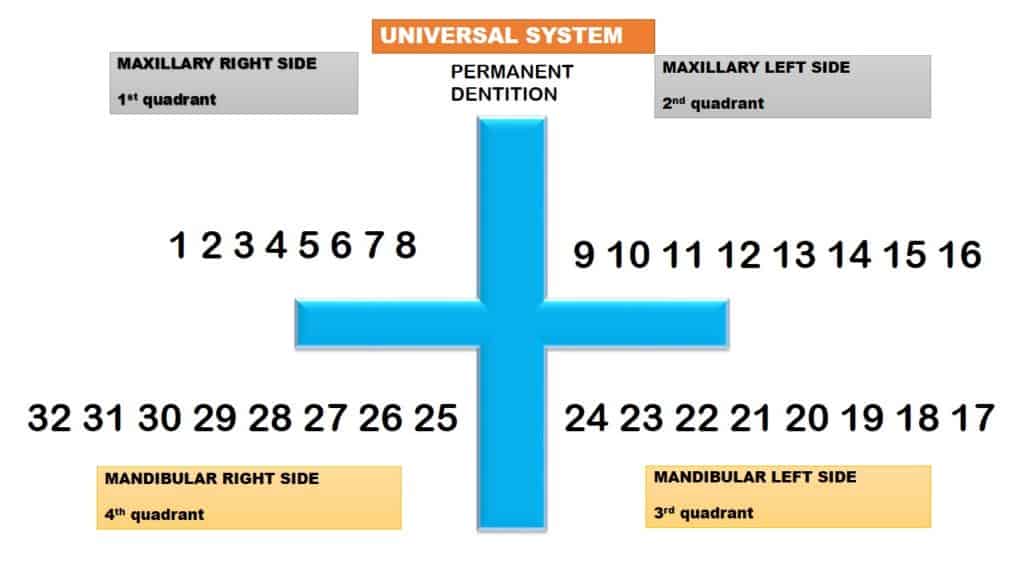
In the deciduous alphabet are used, but in permanent dentition, numbers are used.
Teeth numbers starting from maxillary right quadrant
3rd molar as ‘1’
2nd molar as ‘2’
1st molar as ‘3’
2nd premolar as ‘4’
1st premolar as ‘5’
canine as ‘6’
lateral incisor by ‘7’
central incisor by ‘8’
continue the teeth numbering to the left size
central incisor by ‘9’
lateral incisor by ’10’
canine as ’11’
1st premolar ’12’
2nd premolar as ’13’
1st molar as ’14’
2nd molar as ’15’
3rd molar as ’16’
we start with Teeth numbers mandibular from the left side
3rd molar as ’17’
2nd molar as ’18’
1st molar as ’19’
2nd premolar as ’20’
1st premolar as ’21’
canine as ’22’
lateral incisor by ’23’
central incisor by ’24’
we continue to mandibular right quadrant
central incisor by ’25’
lateral incisor by ”
canine as ’27’
1st premolar as ’28 ‘
2nd premolar as ’29’
1st molar as ’30’
2nd molar as’ 31′
3rd molar as ’32’
Zigmondy and Plamer System
it is named after the designer
Alphabets are fixed for a tooth type.
so all quadrants for deciduous
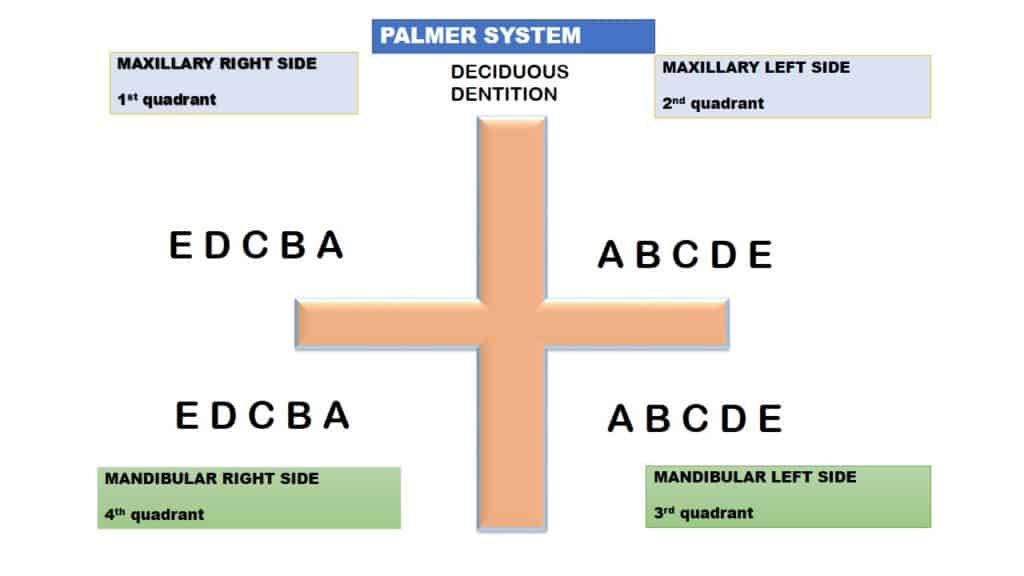
central deciduous incisor of all quadrants by ‘A’
lateral deciduous incisor of all quadrants by’B’
deciduous canine of all quadrants as ‘C’
1st deciduous molar of all quadrants as ‘D ‘
2nd deciduous molar of all quadrants as’ E’
Relate “P” palmer for the plus sign.
In permanent dentition, teeth numbers are used instead of alphabets and fixed for all the quadrant
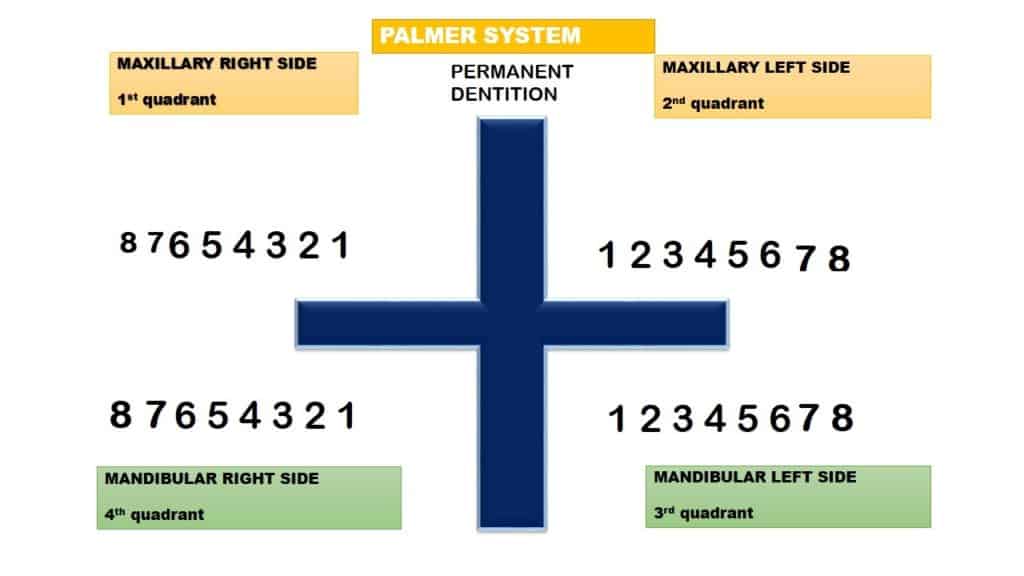
central incisor of all quadrants ‘1’
lateral incisor of all quadrants by ‘2’
canine of all quadrants as ‘3’
1st premolar of all quadrants as ‘4’
2nd premolar of all quadrants as ‘5’
1st molar of all quadrants as ‘6’
2nd molar of all quadrants as ‘7’
3rd molar of all quadrants as’ 8′
for example, the left maxillary canine is represented by ‘3’.
FDI system
Federation Dentaire International adopted by WHO. It is also known as a two-digit system.
The plus sign is not used. So it’s good when you want to store data on a computer.
Two digits are given to a tooth. The first digit represents the quadrant, and the second digit represents the tooth.
The permanent dentition has given 1, 2, 3, 4.
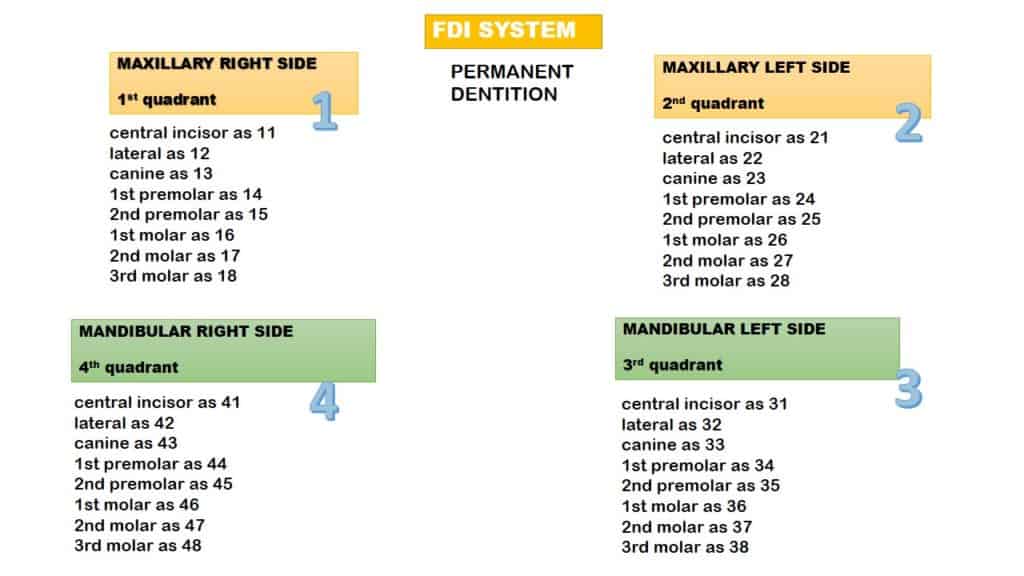
maxillary right quadrant as ‘1’
maxillary left quadrant as’ 2′
mandibular left quadrant as’ 3′
mandibular right quadrant as ‘4’
similarly for deciduous dentition
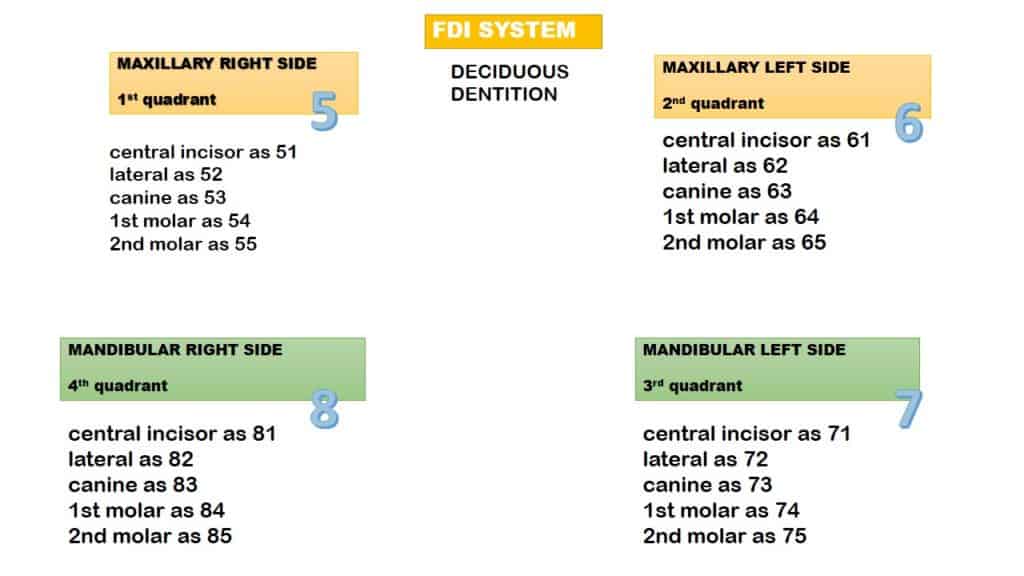
maxillary right quadrant as ‘5’
maxillary left quadrant as ‘6’
mandibular left quadrant as’ 7′
mandibular right quadrant as’ 8′
Maxillary right central is 51 “five-one” and not fifty-one. Similarly, a left maxillary canine is 73 “seven-three,” not seventy-three.
For maxillary right quadrant for deciduous teeth.
all tooth will start with’ 5′
central incisor as’ 51′
lateral as ’52’
canine as ’53’
1st molar as ’54’
2nd molar as ’55’
Tooth numbering for maxillary left quadrant
central incisor as ’61’
lateral as ’62’
canine as ’63’
1st molar as ’64’
2nd molar as ’65’
7 is the number for the mandibular left quadrant.
central incisor as ’71’
lateral as ’72’
canine as ’73’
1st molar as’ 74′
2nd molar as ’75’
Teeth numbers for the mandibular right quadrant
central incisor as ’81’
lateral as ’82’
canine as ’83’
1st molar as ’84’
2nd molar as ’85’
FDI tooth numbering system for permanent dentition
quadrants are divided as 1,2,3,4
Teeth numbers for maxillary right quadrant
central incisor as’11’
lateral as ’12’
canine as ’13’
1st premolar as ’14’
2nd premolar as ’15’
1st molar as ’16’
2nd molar as ’17’
3rd molar as ’18’
Teeth numbers for left maxillary quadrant
central incisor as ’21’
lateral as ’22’
canine as ’23’
1st premolar as ’24’
2nd premolar as ’25’
1st molar as ’26’
2nd molar as ’27’
3rd molar as ’28’
Tooth numbering for mandibular left quadrant
central incisor as ’31’
lateral as ’32’
canine as ’33’
1st premolar as ’34’
2nd premolar as ’35’
1st molar as ’36’
2nd molar as ’37’
3rd molar as ’38’
for mandibular right quadrant
central incisor as ’41’
lateral as ’42’
canine as ’43’
1st premolar as ’44’
2nd premolar as ’45’
1st molar as ’46’
2nd molar as ’47’
3rd molar as ’48’
I recommend you practice the tooth numbering system.
Comment in the section below as per FDI tooth numbering system one-six is which tooth?
Pingback: KNOW SELECTION CRITERIA FOR PONTIC AND DESIGNS! - extooth